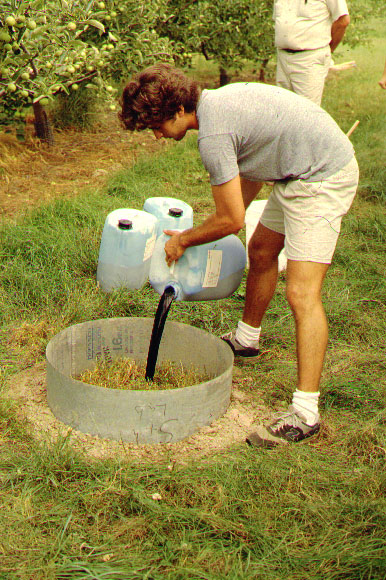|
|
|
DYE
TRACER FOR IDENTIFYING WATER AND SOLUTE FLOW PATHS IN SOILS
Dyes are valuable tracers
to study the movement of water and solutes in soils and aquifers.
Various types of dye have been used to visualize the flow paths
of water or solutes in soils, or to estimate the frequency, size,
and spatial distribution of pores in soils (Table 1). For tracing
water or solute movement, a dye should preferably be mobile, visible,
and nontoxic. Based on research conducted by Flury and Flühler
in 1994, Brilliant Blue FCF is the best dye compromising these preferences.
This type of dye provides good visibility against the color of the
soil's (structured and unstructured) background and has low toxicity,
however, its mobility is not ideal for tracing the travel times
of water or solute itself because Brilliant Blue FCF is absorbed
by soil material (Table 2). In order to detect flow patterns in
soils, combining Brilliant Blue FCF with conservative tracers such
as Cl- or Br- (which are not absorbed) is useful, and in turn, may
serve as guidance for an efficient sampling strategy for additional
chemicals (since the adsorptive behavior of organic chemicals, i.e.
pesticides, is mimicked by dyes). The leading edge of a moving waterfront,
which could be missed by the dye, can be determined with Cl- and
Br- tracers.
Table 1. Selected dyes used to mark the flow of water and solutes
in soils (Flury and Flühler, 1995)
|
Commercial
name
|
C.I.generic
name
|
C.I.constitution
number
|
Hue
|
Chemical
class
|
| Nonfluorescent
dyes |
|
|
|
|
|
Azo Geranine 2G |
C.I.
Acid Red 1 |
18050 |
bright
bluish red |
Monoazo |
|
Lissamine Green |
C.I.Acid
Green 50 |
44090 |
bluish
green |
Triphenylmethane |
|
Methylene blue |
C.I.
Basic Blue 9 |
52015 |
bright
greenish blue |
Thiazine |
|
Alizarin Red S |
C.I.Mordant
Red 3 |
58005 |
bright
yellowish red/ |
Anthraquinone |
| |
|
|
dull
bluish red |
|
|
Ultramarine Blue |
C.I.
Pigment Blue 29 |
77007 |
bright
bluish green |
inorganic |
|
Disperse Orange 3 |
C.I.
Disperse Orange 3 |
11005 |
orange |
Azo |
|
Indigo Carmine |
C.I.
Food Blue 1 |
73015 |
blue |
Indigoid |
|
Brilliant Blue FCF |
C.I.
Food Blue 2 |
42090 |
bright
greenish blue |
Triphenylmethane |
|
Erythrosyne BS |
C.I.
Food Red 14 |
45430 |
bright
bluish red |
Zanthene |
| Fluorescent
dyes |
|
|
|
|
|
Rhodamine WT |
C.I.
Acid Red 388 |
n.a. |
n.a. |
Xanthene |
|
Lissamine Yellow FF |
C.I.
Acid Yellow 7 |
56205 |
bright
greenish yellow |
Aminoketone |
|
Fluorescein |
C.I.
Acid Yellow 73 |
45350 |
bright
yellow |
Xanthene |
|
Pyranine |
C.I.
Solvent Green 7 |
59040 |
yellowish
green |
Anthraquinone |
|
Amido-G-Acid |
n.a. |
n.a. |
n.a. |
n.a. |
*C.I.
= Color Index
Table
2. Selected properties of Brilliant Blue FCF (disodium salt) (Flury
and Flühler, 1995)
| Common
name |
Brilliant
Blue FCF, C.I. Acid Blue 9,FD&C Blue no. 1, C.I. Food Blue
2 |
| Classification |
Triphenylmethane
dye |
| Molecular
formula |
C37H34N2Na2O9-S3 |
| Color
Index (C.I.) |
42090 |
| Aqueous
solubility |
200
kg/m3 (2, 25, 60oC) |
| pKa |
5.63,
6.58 |
| Molar
mass |
792.85
g/mol |
| Absorption
maximum |
630
nm |
| Absorptivity
# |
164
m3/(kg.cm) |
Blue dye demonstration
- An infiltration ring
(i.e. 0.7-m diameter) is driven into the soil at a specific depth
(i.e. 1-cm depth).
- Apply a certain amount
of dye into the ring (Figure 1). For 0.7-m diameter ring, 20 liters
of 1% Brilliant Blue FCF dye solution in the ring provides a mean
application depth of 5.4cm.
- Start excavation after
all dye infiltrates.
- Excavate a 1 to 2-m
deep pit next to the dyed area, and excavate laterally to expose
undisturbed vertical soil profiles (i.e. Figure 2).

Figure
1. Pouring a blue dye

Figure
2. Dyed soil profile.
References
Flury, M., and H. Flühler.
1994. Brilliant Blue FCF as a dye tracer for solute transport studies-A
toxicological overview. Journal of Environmental Quality.
23:1108-1112.
Flury, M., and H. Flühler.
1995. Tracer characteristics of brilliant blue FCF. Soil Science
Society of America Journal. 59:22-27.
Preferential Flow
|

